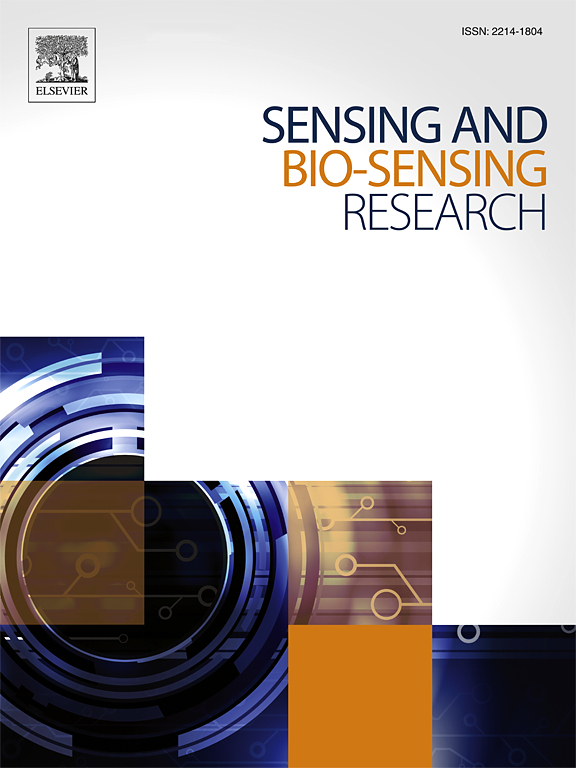Polyrotaxane-containing hydrogels for label-free detection of C-reactive protein (CRP) via diffraction gratings
IF 4.9
Q1 CHEMISTRY, ANALYTICAL
引用次数: 0
Abstract
Hydrogels have been investigated as label-free (LF) holographic biosensors thanks to their ability to change the hydrogel structure when interacting with specific analytes. In this work, we report the development of hydrogel-based holographic diffraction gratings incorporating polyrotaxanes as crosslinkers and phosphorylcholine for the selective and label-free detection of C-reactive protein (CRP), which is a key biomarker for cardiovascular disease, sepsis, and inflammatory disorders. Phosphorylcholine-functionalized monomers were added to the hydrogel composition for specific CRP recognition, while methylated polyrotaxanes (PR-Met) were incorporated to enhance mechanical stability and elasticity. The materials were characterized via scanning electron microscopy (SEM), swelling studies, and mechanical compression tests, demonstrating improved robustness compared to conventional hydrogels. Fluorescence-based assays confirmed the specificity of CRP binding, and diffraction efficiency measurements enabled direct quantification with a limit of detection (LOD) of 0.3 mg L−1. The system was successfully tested using certified human serum samples, achieving recovery rates within the clinically accepted range. This study highlights the potential of polyrotaxane-mediated mechanically enhanced hydrogels as a promising platform for biomolecular sensing, offering improved sensitivity, selectivity, and mechanical resilience for future clinical applications.

含聚轮烷的水凝胶通过衍射光栅无标记检测c反应蛋白(CRP)
由于水凝胶在与特定分析物相互作用时能够改变水凝胶结构,因此水凝胶已被研究作为无标签全息生物传感器。在这项工作中,我们报道了以聚轮烷为交联剂和磷酰胆碱为基础的水凝胶全息衍射光栅的发展,用于选择性和无标记检测c反应蛋白(CRP),这是心血管疾病,败血症和炎症疾病的关键生物标志物。在水凝胶组合物中加入磷酸胆碱功能化单体以特异性识别CRP,而加入甲基化聚轮烷(PR-Met)以增强机械稳定性和弹性。通过扫描电子显微镜(SEM)、膨胀研究和机械压缩测试对材料进行了表征,表明与传统水凝胶相比,材料的鲁棒性得到了改善。基于荧光的检测证实了CRP结合的特异性,衍射效率测量可以直接定量,检测限(LOD)为0.3 mg L−1。该系统使用经过认证的人血清样本进行了成功的测试,回收率在临床可接受的范围内。这项研究强调了聚轮烷介导的机械增强水凝胶作为生物分子传感的一个有前途的平台的潜力,为未来的临床应用提供了更高的灵敏度、选择性和机械弹性。
本文章由计算机程序翻译,如有差异,请以英文原文为准。
求助全文
约1分钟内获得全文
求助全文
来源期刊

Sensing and Bio-Sensing Research
Engineering-Electrical and Electronic Engineering
CiteScore
10.70
自引率
3.80%
发文量
68
审稿时长
87 days
期刊介绍:
Sensing and Bio-Sensing Research is an open access journal dedicated to the research, design, development, and application of bio-sensing and sensing technologies. The editors will accept research papers, reviews, field trials, and validation studies that are of significant relevance. These submissions should describe new concepts, enhance understanding of the field, or offer insights into the practical application, manufacturing, and commercialization of bio-sensing and sensing technologies.
The journal covers a wide range of topics, including sensing principles and mechanisms, new materials development for transducers and recognition components, fabrication technology, and various types of sensors such as optical, electrochemical, mass-sensitive, gas, biosensors, and more. It also includes environmental, process control, and biomedical applications, signal processing, chemometrics, optoelectronic, mechanical, thermal, and magnetic sensors, as well as interface electronics. Additionally, it covers sensor systems and applications, µTAS (Micro Total Analysis Systems), development of solid-state devices for transducing physical signals, and analytical devices incorporating biological materials.
 求助内容:
求助内容: 应助结果提醒方式:
应助结果提醒方式:


